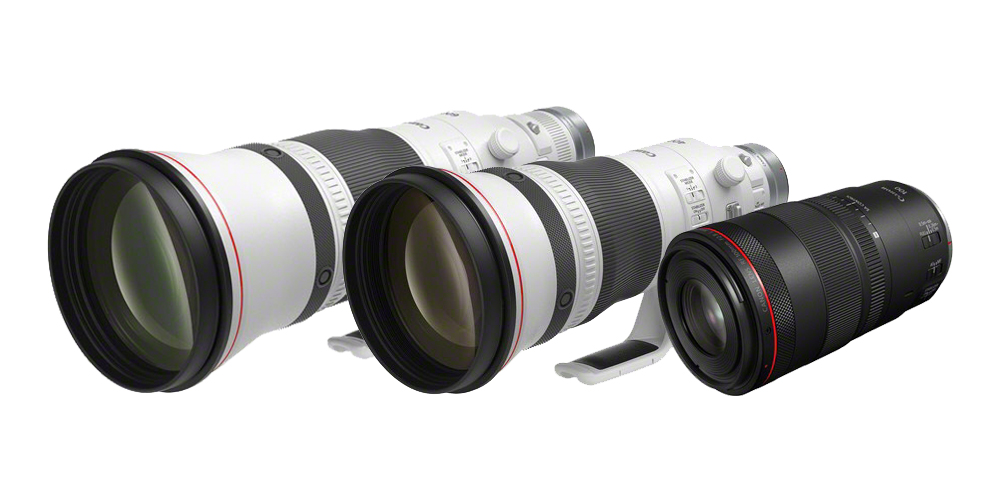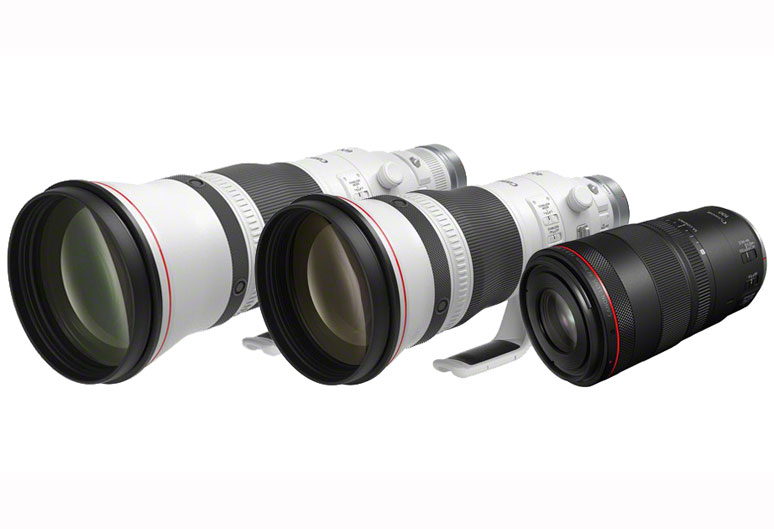Canon has expanded its lens range for the full-frame EOS R mirrorless system with the addition of two blockbuster super-telephoto RF lenses:
Canon RF 800mm f5.6 L IS USM
Canon RF 1200mm f8.0 L IS USM
Canon have made EF versions of these focal lengths in the past, the legendary EF 1200mm f5.6 L from 1993 is incredibly rare. They were made to order, there is only speculation about how many were ever produced and we have never seen one at Fixation. More recently in 2008 the EF 800mm f5.6 L IS USM had the new benefits of Canon image stabilisation and magnesium alloy build for lighter weight however it was still 4.5kg
Times and technologies have moved on and while we saw mark II and mark III versions of the 300mm and 400mm super telephoto lenses which were ever lighter, better balanced, with more advanced stabilisation systems and power aperture control rings, there was never a revision to the 1200mm or 800mm lenses until today.
Lenses are available to pre-order, contact our sales team on sales@fixationuk.com or call us on 020 7582 3294 for more information.
Key specifications compared
| RF 1200mm f8.0 L IS USM | RF 800mm f5.6 L IS USM | EF 1200mm f5.6 L | EF 800mm f5.6 L IS USM | |
|---|---|---|---|---|
| Release Year | 2022 | 2022 | 1993 | 2008 |
| Focal Length | 1200mm | 800mm | 1200mm | 800mm |
| Maximum Aperture | f/8.0 | f/5.6 | f/5.6 | f/5.6 |
| Weight | 3.34kg | 3.14kg | 16.50kg | 4.50kg |
| Image Stabilisation | Yes: 4 Stop IS | Yes: 4.5 Stop IS | No | Yes: 4 Stop IS |
| Close focus distance | 4.3m | 2.6m | 14.0m | 6.0m |
| Price | £22,449 | £19,099 | No longer available | £13,549 |
Lenses are available to pre-order, contact our sales team on sales@fixationuk.com or call us on 020 7582 3294 for more information.
Are they really compact lightweight and portable?
This depends on your perspective, if you are used to using telephoto lenses, especially if you used to use 1990s and 2000s mark I telephoto lenses from Canon then the answer is yes! The difference between those early telephoto lenses and what Canon can produce now is phenomenal. So much so that we often have to double check the cases of the mark III EF telephoto lenses to make sure there is a lens in them. When you are used to the heavier kit, the new kit feels like it is barely there.
On the other hand if you are used to small lenses eg. 70-200mm f2.8, 24-105mm f4.0, prime lenses under 180mm, then the answer is no. Any supertelephoto lens will seem large and unwieldy to start with. They are “long” lenses by definition super telephoto lenses have to be longer and larger to magnify subjects at a great distance. The lenses have their own cases and cannot be put into a normal backpack along with your camera and flash, when travelling overseas this is a significant consideration.
In the end it is down to what you are used to as a photographer, and if you have never used a telephoto lens before don’t worry you can it takes a little practice but the results are well worth it. If you do travel regularly, covering international sport for example, this becomes a normal part of your travel planning.
Telephoto lenses launched April 2021:
Canon has announced three new lenses in the RF range: An RF 100mm f2.8 L Macro USM, Super-telephoto RF 400mm f2.8 L IS USM and, even longer a Super telephoto RF 600mm f4.0L IS USM.

All three lenses use Canon L series optics and are RF versions of tried and tested EF lenses updated for EOS R mount mirrorless digital cameras.
Canon RF 100mm f2.8 L Macro IS USM Lens £1,449
Canon RF 400mm f2.8 L IS USM Lens £12,449
Canon RF 600mm f4 L IS USM Lens £13,409
To place an order with our sales team, call us on 0207 582 3294 or email sales@fixationuk.com
Canon RF 100mm f2.8L Macro USM
The 100mm is a versatile lens which delivers excellent macro images but it is by no means limited just to macro photography. The earlier version of this lens for DSLR camera bodies (EF 100mm f2.8L IS Macro USM) was prized for it’s revealing, clear images and used by beauty, product and portrait photographers as well as extensively for artwork reproduction and archive digitization. The image stabilization on a short telephoto was a real boon for early DSLR filmmakers working with the EOS 5D series and Cinema EOS systems.
In short, we’re confident this lens will be a popular choice for a wide range of photographers using EOS R cameras and may tempt more to move to mirrorless.
Fast close focusing
This lens achieves fast, precise and controlled focus, in near silence by using two Nano USM autofocus motors to drive two separate optical element groups. A floating lens group (which required the use of a second focus motor) is used to make the lens more compact and to focus closer for up to 1.5x magnification. Shorter distances within the lens make focusing faster.
The independent movement of the two optical groups also suppresses focus breathing, the subtle change in magnification seen when focusing a traditional optical system.
Rock steady image stabilisation
The hybrid IS system in the RF 100mm f2.8L IS Macro USM delivers up to 5 stops of image stabilisation in the lens alone. Paired with the in-body image stabilisation of the Canon EOS R5 the lens is capable of up to 8 stops of image stabilisation. Both of these measurements have been tested independently by CIPA.
It is worth noting that the stabilisation is tested at a standard subject distance and not at a macro distance. Because macro photography is much more revealing of shake and subject movement, Canon state that the IS delivers 2-stops of stabilisation when shooting at 1x magnification. For greater macro stability the lens has an optional tripod attachment ring.
Spherical Aberration (SA) control
A defining feature of this lens is the addition of a Spherical Aberration Control ring. The SA Control gives photographers more control of depth of field and bokeh by moving the floating element group independently. This allows you to alter the look of your bokeh and defocus in front of and behind the subject.
Canon RF 100mm f2.8L Macro IS USM Lens £1,449
To place an order with our sales team, call us on 0207 582 3294 or email sales@fixationuk.com
Canon RF 400mm f2.8 L IS USM and RF 600mm f4.0 L IS USM
Two fast telephoto lenses are set to bring Canon mirrorless cameras into the world of professional sport and wildlife photography. These lenses give photographers the ability to capture the action while staying safely on the sidelines. 400mm is a standard length for football and rugby while 600mm is the go-to for cricket and golf. Outside the world of sport, the 600mm is highly prized by bird photographers and both focal lengths are used by wildlife photographers around the world.
Fast AF with Dual Power focus drive
These lenses are often used to track moving subjects. Canon have added a second power connection point to the lens mount so that with compatible cameras the lenses can draw more power for faster focusing and more accurate subject tracking.
Both lenses have a full time manual focus override so you can quickly adjust focus without switching focus modes. The 600mm allows you to set three manual focus speeds for precise control.
Portable
These are large lenses, the long focal lengths and wide apertures make these lenses objects that often dwarf the camera attached. Canon have done all they can to make such large lenses as light and easy to use as possible. Using lightweight alloys for the barrels the 400m is the lightest 400mm f2.8 for mirrorless cameras on the market at only 2.89kg. The 600mm is only a fraction heavier at 3.09kg.
Canon are no longer providing these lenses in bulky flight cases instead opting for reinforced soft cases to reduce the overall weight of the kit while travelling.
Canon RF 400mm f2.8 L IS USM Lens £12,449
Canon RF 600mm f4 L IS USM Lens £13,409
To place an order with our sales team, call us on 0207 582 3294 or email sales@fixationuk.com
To stay in the loop for future events and announcements sign up to the Fixation newsletter.

